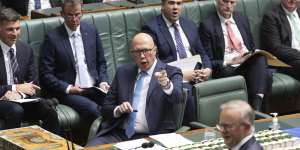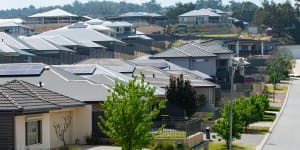Anthony Albanese left parliament on Thursday night feeling chuffed about a surprise victory in the Senate at the exhausting end of a gruelling fortnight.
The prime minister and his Labor colleagues took the Coalition by surprise with a last-minute deal to set up a new federal authority to help cut greenhouse gas emissions to net zero by 2050. Long opposed by the Liberals and Nationals,the new law was passed with the support of the Greens and most crossbenchers in the upper house.
Albanese claimed a win for Labor aftertwo weeks of derision from Peter Dutton. While the opposition leader spent question time attacking the prime minister for accepting Palestinians who had fled the war in Gaza,cabinet ministers pointed to the votes in parliament as proof they were making progress with the business of government.
The law to set up the Net Zero Economic Authority is just one small part of the Labor agenda. The new agency is meant to oversee the transition from coal to renewable energy,making it another building block in a deeply controversial energy plan. Labor had been trying to pass the law since March.
But the broader agenda is in trouble. Labor is being blocked in parliament from putting some of its ideas into action. And it is being rebuked outside parliament for not having enough big ideas in the first place.
With only six weeks of parliament left before the end of the year,Albanese and his cabinet ministers are running out of time to get things done. And they are yet to outline a bold agenda for the future.
“I had genuinely hoped that they would use the second half of their first term to build the case for a more ambitious reform mandate for a second term,” independent economist Saul Eslake says. “But they’ve conspicuously failed to do that.”
Eslake credits the government with good decisions on the economy and the federal budget. He rates Treasurer Jim Chalmers highly,does not blame the government for high inflation,and praises the rejig of the“stage three” personal tax cuts earlier this year. But he worries that the budget is swinging to a structural deficit. And he is sceptical of the big-spending ideas in theFuture Made in Australia industry policy.
“Jim Chalmers is,I think,by far the government’s most effective communicator,” he says. “But he hasn’t been able to persuade his colleagues to embrace a more ambitious reform agenda going into next year’s election.”
Tax reform is one example. Chalmers poured cold water on the idea of major reform during aninterview with this masthead for theInside Politics podcast this week.
“I think tax is always a part of the national economic debate,” he said. “That’s a good thing,but our priorities really are still trying to finish some of the big tax changes that we are already trying to legislate.”
No hint there about anything too bold.
Aged Care Minister Anika Wellstried to get a deal in the past week with her Coalition counterpart,Liberal senator Anne Ruston,but the changes are too ambitious to go through smoothly. Many Australians already pay steep fees for aged care and the principle of “user-pays” cannot be extended without blowback. Health services will be funded by government,but those with the means to pay for food and accommodation will be expected to pay more.
Ideas that define the character of a government,even if they are not priorities for voters,have also led to mixed results. Attorney-General Mark Dreyfus delivered on a promise to set up aNational Anti-Corruption Commission,a pledge the previous government dodged for years,but the government is yet to reveal itsnew curbs on political donations.

Opposition Leader Peter Dutton and Prime Minister Anthony Albanese during question time on Monday.Credit:Alex Ellinghausen
“Progress on donations reform and truth in political advertising has been inexplicably slow,with the result that no improvements will be in place before the next election,” says Catherine Williams,the executive director of The Centre for Public Integrity,a not-for-profit group set up by former judges.
“Grants administration reform has not progressed in any meaningful way,with pork barrelling remaining as possible now as it was before the last election.”
Hard decisions are dragged out,while some are left in limbo. Albanese has shelved anew law to enshrine religious freedom because he cannot get an agreement with Dutton on protections for LGBTQ people. Just like his predecessor,Scott Morrison,the prime minister has discovered that the promise is easy and the action is hard.
Cabinet ministers are yet to agree on curbs on gambling advertising after months of calls for a total ban,including from Labor,Liberal,Nationals and crossbench MPs. The likely option is a cap on advertisements –the draft plan is two per hour on television – but Labor is exposed to claims that it is caving to the media,sports and gambling bosses.
Albanese began this term with an assurance that he would run an “orderly” government. But this process can slow things down to a point where the government hardly moves at all.
Election flashpoints
Housing will be one of the defining issues of the coming election,but key observers are still waiting for concrete outcomes from all the Labor ideas. The government has set up the $10 billion Housing Australia Future Fund and committed $22 billion to other policies,including big payments to the states,but it is hard to measure whether it has added to supply. It has also increased Commonwealth Rent Assistance by 26 per cent over two years.

The Grattan Institute’s Brendan Coates believes Labor has to be more ambitious on housing.Credit:Ross Swanborough
“The Albanese government has done a lot of good things on housing,” Grattan Institute program director Brendan Coates says.
“The trouble is,they shrink in comparison to the scale of the housing problem Australia faces. Housing has never been less affordable in Australia than it is today. Rents have risen 15 per cent in the past two years alone. Yet,it’s never been harder to build homes.”
Coates believes Labor has to be more ambitious. While the government has a target of adding 1.2 million homes over the coming five years,he says this could drag Labor down unless it does more to achieve the goal. He thinks the future fund could be doubled to $20 billion to spur more investment.
“Many of the big levers,not least planning reform,sit with the states,” he says. “But there are steps the federal government can take to tackle the triple challenges of the price and availability of building materials,labour and finance.
“If the government can’t come up with better answers soon,it could bear the brunt of renters’ frustration at the next election.”
Loading
Another election flashpoint is energy. Dutton has a proposal,but not a detailed plan,tobuild nuclearpower stations to supply reliable power without carbon emissions. And his idea does nothing to add electricity generation in the decade ahead. Albanese has a policy,under way but far from complete,to build more renewable energy and upgrade the transmission grid. The easy part is using taxpayer money to subsidise bills. The hard part is adding enough capacity,fast,to ensure the electricity grid can support a growing population with more air conditioners and electric vehicles.
Grattan Institute energy program director Tony Wood acknowledges Labor’s action on emission targets but says there is much more to do. There is a review of the electricity market,the steps to get to net zero by 2050 and the “capacity investment scheme” that is meant to add more power generators to the grid. He worries about the gap between what Australia needs and what is being built.
“Can that gap be closed? Yes,” Wood says. “But it’s a very tricky challenge. I don’t think it’s all going to fall apart,but it’s not all going well.”
It is on Albanese and Dutton to prove to voters that their competing energy ideas can work.
This is central to the top priority at the election,the cost of living. On the current numbers,Labor can assure voters inflation is easing and real wages are moving a little higher,but it cannot tell them real wages have risen over the lifetime of this government. Albanese and Chalmers have come to power at a crunch point in household income.
Loading
Chalmerswants to run a tight budget to avoid any blame that he is adding to inflation. He told this masthead’sInside Politics podcast the March budget will not be a “spendathon” because fiscal policy must be kept under control. Albanese,however,haslost ground in the polls and will be tempted to burn a little budget fuel to win the election.
Dutton,meanwhile,has no economic plan to address the cost of living and is taking longer than usual to set out any ambitions beyond nuclear energy and some relatively minor policies.
Leading up to the 2022 federal election,the key dates were the March 29 budget,the April 10 election announcement,and the May 21 polling day. Labor has the option of moving faster than that,but the Parliamentary Library names May 17 as the last date for a standard half-Senate election.
The government is running out of time to get things done. Albanese has only five months until Australia Day – the end of the summer holidays and the unofficial start of the 2025 campaign. The competing campaigns must be ready by February at the latest,with Dutton just as aware of the deadline as Albanese.
The final stage of this term of parliament is now under way. The two leaders are yet to reveal their competing agendas for the term to come. And time is short.
Cut through the noise of federal politics with news,views and expert analysis.Subscribers can sign up to our weekly Inside Politics newsletter.